
The mystery of the Moor King’s Water Mine of Ronda
By Ana M. Carreño Leyva
El legado andalusí Andalusian Public Foundation
The defence of Ronda meant, as in every border-city, one of the most important challenges both in times of peace and war. Ronda, along the Route of Almoravids and Almohads, keeps the secret of its astounding water mine, whose story is hardly knowm.
The Romantic image of Ronda that captivated the artists who travelled along Southern Spain was also anchored in the legendary legends of its landscape and ancient remains. Many of these kept secrets unknown to most of us, as we sometimes move around unaware of what lies under our feet.

View of the House of the Moor King to the right, on the Tajos’s edge. ©Diputación de Málaga.
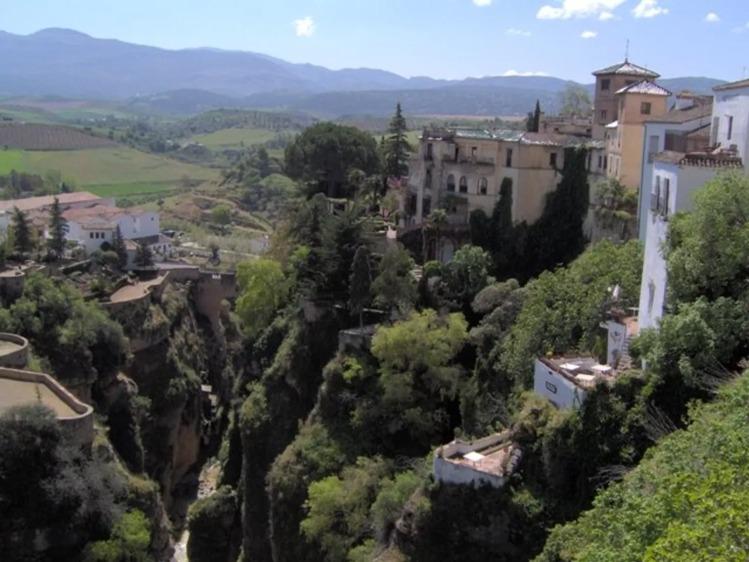
This is the case with the water mine known as Mine of the Moor King, hosted in the gardens of the house under the same name. Its access is through a vertical tunnel descending from the ground level at the edge of the famous ravine (Tajo) in Ronda. The very name of “House of the Moor King” is not accurate, for there is not historical references regarding the ownership of a Moor king whatsoever.

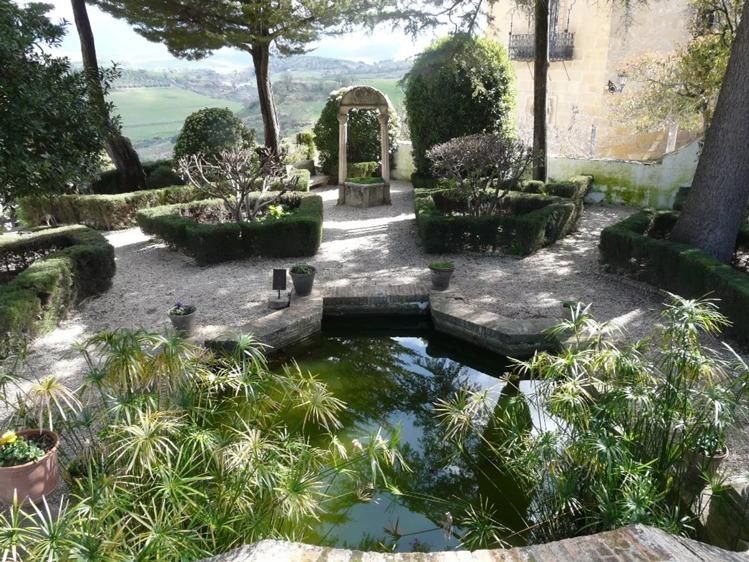
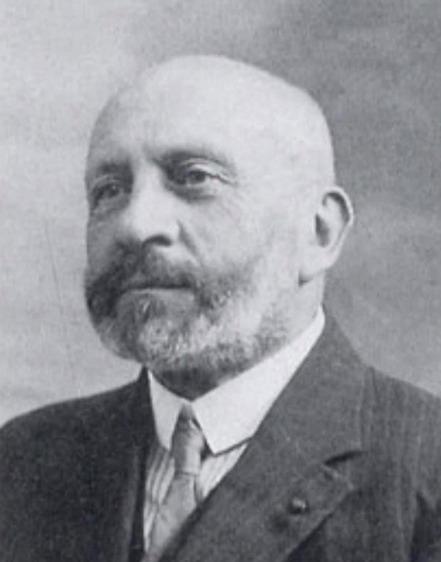
Left, portrait of the Duchess of Parcent by the 19th c. realist painter Raymundo de Madrazo At the centre, a view of the Andalusi garden designed by famous French landscaper Jean-Claude Nicolas Forestier, (1861-1930).
The original setting was the typical Andalusian 18th century aristocratic building, which still preserved several buildings at the beginning of the 20th century. Regarding the archaeological remains that help to give evidence of the existence in the site of an access to the main, which no doubt was a coracha, (qawraja in Arabic) we do not have news. Corachas were fortifications that sheltered a source of water, mostly a well, whose use was saved mainly for siege situations or extreme danger for the population and the armies that defended it.
Although we are not certain about the date of the construction of the water mine, we know that it was the place chosen to install the water mine given its strategic value. The water mine of the Moor King is a very singular coracha, and more than a defensive construction it was a monumental work of hydraulic engineering. It was fed by water from a well and water extracted from the river.
The property was owned by the duchess of Parcent, who in 1911 ordered to build the villa in this magical enclave, on the edge of a precipice on the south side of the Tajo. The house was adorned with a garden of extraordinary beauty, a work by French landscape architect Jean-Claude Nicolas Forestier, who also designed the gardens of the Park of María Luisa in Seville.
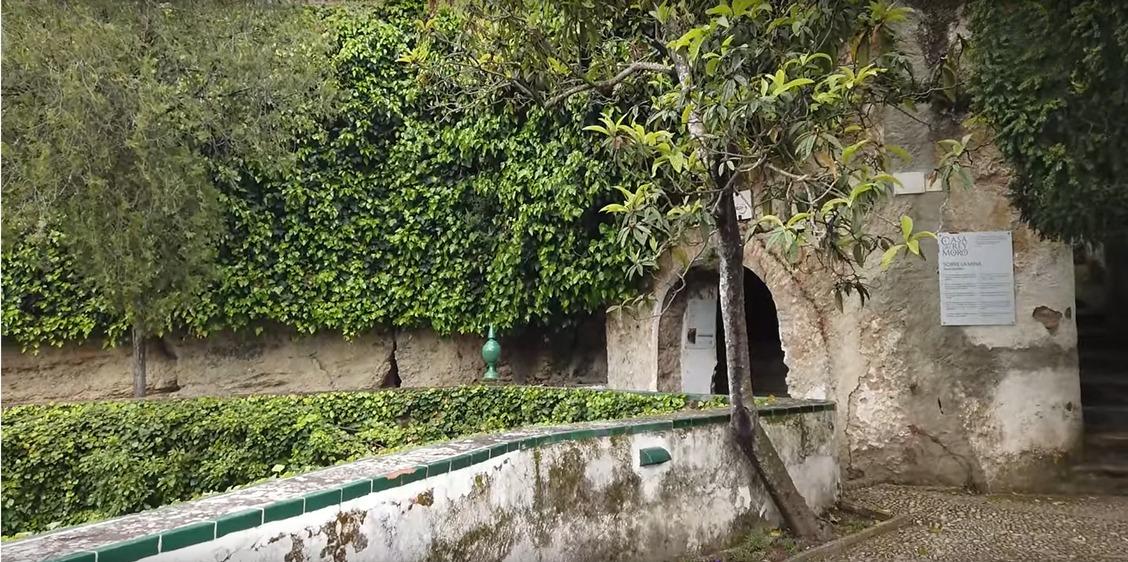
Arch-shaped entrance to the water mine.
To the beauty of the spot, its unknown history adds a great dose of mystery. What we commonly find in Arab chronicles, though briefly, are references to the advantages that the cora, or district, of what they named Takurunna had due to its rugged terrain.
When the Christian conquest of the Ronda had just ended, Andrés Bernáldez, the secretary of the Catholic Monarchs and historian, wrote:
” […] the Moors had a secret mine in Ronda … where they came down to collect the water they needed from three wells they had built at the bottom, by the water’s edge. … The Marquis of Cádiz was informed, and he himself with his soldiers fought there, and ordered the construction of a gate in the wall of the large ravine where he discovered the staircase, put people inside to guard that water, from inside the vault of the mine. And in this way the Marquis if Cádiz took the supplies of water; for this, the Moors were much afflicted … and they could not hold on […].”
The mine had different openings or small arches in its outside wall, allowing the defending soldiers to take position in them to shoot.

Galleries inside the water mine. Left and center ©Dick Doughty. Rigth. ©Diputación de Málaga
The water mine played its most important role in the troubled times of the Christian conquest of al-Andalus, when history was written from the perception of one or the other side, while border lines fluctuated at the mercy of the advance of troops.
By mid-14th century, Ronda was an important place for the defence of the border areas to the West of the Nasrid Kingdom. The important kora of Ronda, Takurunna, was a ruled between 1333 and 1339 by King Abd-al Malik (Abumalic in Spanish version), of Marinid [1] origin. The importance of the disputed cora of Ronda was due to its status as a frontier land, and its main secret weapon to defend itself from siege was the water mine.
The battle of conquest of Ronda took place in 1485, and the troops of the Marquis of Cádiz attacked the water mine as it was Ronda’s strongest defence, for the water provision permitted the city to survive, resisting the siege. Christian victory was only possible as a result of the seizing of the water mine of the Moorish King. Without water, the city had only to surrender in a matter of days.
[1] Marinids were dinasty of Zanata Berber origin which controlled the North of Africa and the South of Spain and wester Morocco during a short period of time.
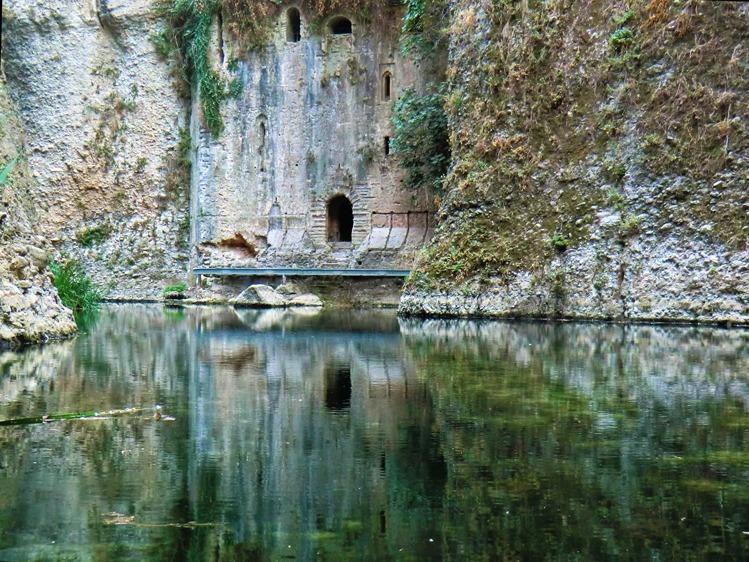

Its access from the river, at the bottom of the Tajo, also allowed flight in case of a need to escape from attacking forces. Apart from arms, they also used such medieval methods as throwing boiling oil or water on top of invaders.
Left: current image of the water mine. Right: access to the water mine from the bottom of the gorge in an image from the time of the construction of the Marquis of Parcent’s residence in early 20th c. ©Isabel Bestué Cardiel and Emilio Molejo Melgarejo.
As we get into the water mine, a space carved in the limestone, as is the entire ensemble, leads us to a staircase whose ceiling has a variable height and is composed of 231 steps, and was built taking advance of the natural formations and the protruding rocks. Its builders are also shrouded in mystery. According to most sources, it might have been a work of the Berbers from Ifran (11th c.) from whom we have scant information. According to post-conquest chronicles, the mine, 60 metres long, was constructed by captive Christians who, in addition to hewing the rock, carrying the water by hand using zaques[1] after its extraction from the river, were also responsible for turning the water wheel.
Animal traction was not possible given the site layout, with unstable and slippery stairs due to humidity and the height of the ceiling that changed at each level. We can still see the place where the waterwheel stood, which loaded the extracted water from the river, 15 metres further down, in goatskins that slaves later transported, one sack after another, to be deposited in a water tank located somewhere on the surface. This specific place gives us an idea about the very hard work and the poor conditions in which captives laboured, because, among other hardships, the waterwheel was some 15 metres below the water.
The sensation while we descend this vertical tunnel is daunting. Light apertures arranged in the wall at irregular intervals create an eerie atmosphere conducive to countless legends that have occupied the place of history due to the lack of accurate data. For instance, before the uncertainty of the authorship of the workers who carved and dug the water mine, some sources point to the Christian captives as being the authors, as history attempts to be supported by the existence of crosses scratched into the walls.
[1] Goatskin flasks.
The water mine structure consists of a labyrinthine framework of spaces, sort of rooms −from which also we have no accurate information about their use− that are adjacent to both sides of the staircase, and at different heights. Did some serve for quartering soldiers? Or maybe as a prison, or a stock of weapons and ammunition?

Flight of stairs showing how the natural disposition of the stone walls is used in the distribution of different spaces. ©Dick Doughty.
Nevertheless, the most mysterious of all the rooms in the water mine is the so-called “Hall of Secrets”. Its mere shape is of course confusing, for it is about a space with a vaulted ceiling crowned by a hemispheric dome that sits on pendentives in the style of a qubba.
”. Arabist and historian Virgilio Martínez-Enamorado comments to us: “A qubba has a very special character, for it is normally used in mausoleums or shrines, usually in pilgrimage sites, or inside the throne rooms or aulic spaces. It is, as best, a highly multifunctional space.”
It owes its name to the fact that its architecture plays a key role in acoustic reproduction, allowing the sound of a whisper to travel from a corner to its opposite. According to Christian chronicles, Marquis of Cadiz’s troops were garrisoned here during the conquest of Ronda.

Vista parcial de la bóveda de la Sala de los Secretos. ©Dick Doughty
And we go back to legend. It is said that this was a place for the ladies of the Moor king’s court to relax after bathing in the Gaudalevín River that runs in the bottom of the gorge.
There is another indication that the river at the entrance to the mine from the water, protected from unwanted viewing by a natural winding, was the place chosen for bathing and entertainment. This is explained by the exquisite and carefully decoration at the entrance to the water mine from the water is something quite unusual in a secret military enclave.
The secret water mine of the House of the Moor King has been open to public visit since 1990. Consolidation works have been undertaken in its interior, and the access to the bottom of the gorge has also been improved. Here a platform has been installed to allow the visitor to get an uncommon, bottom-up view of the gorge, and gaze upon the rugged relief of its walls.
By Ana M. Carreño Leyva
El legado andalusí Andalusian Public Foundation
